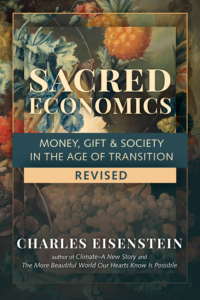Climate — A New Story
Chapters
Chapter 9: Energy, Population, and Development
Population
One arena where the question “Who do we want to be?” takes concrete significance is the issue of population control, where again quantitative thinking draws us into the wrong debate. I detour onto this subject mainly because whenever I post an article on some environmental topic, invariably I receive comments to the effect that I have ignored the “elephant in the room”; namely, population growth. After all, it seems obvious that no matter how green our lifestyle, the planet will be unable to support an endlessly growing population, while if we could reduce population to, say, 1900 levels, then current consumption patterns would pose little problem.
Ah, another simplifying narrative that promises salvation if only we can reduce a global number.
Like many simplifying narratives, however, the fixation on population obscures more fundamental issues. One of them is resource consumption. If everyone consumed resources at the rate of an average North American, the sustainable world population would be about 1.5 billion. If everyone lived the lifestyle of an average Guatemalan, the present population would be sustainable. And if everyone lived as ecologically as a traditional Indian villager, the planet could sustain 15 billion people or even more.[5] Most estimates put the carrying capacity of the planet at between 8 and 16 billion people, although some experts give figures diverging wildly from this range, from less than a billion to upward of 50 billion.[6]
It would sure be comfortable to stop talking about our own resource consumption, and instead limit the reproduction of people “over there.” As most industrialized countries already have birth rates below the replacement rate, the population discourse puts the onus of responsibility on less developed countries.
Like GDP or CO2 levels, what is and is not counted tends to reflect the interests of those doing the counting. Enforced through political power, the choice of what to count often tramples the interests of the powerless. Just as GDP renders other kinds of wealth invisible, just as the greenhouse gas narrative devalues natural beings that have no obvious climate relevance, so has the population scare resulted in questionable policies aimed especially at the world’s most vulnerable people.
The population control movement shares close historical links with the eugenics movement. Early twentieth-century scientific consensus held that modern technology had circumvented natural selection, threatening humanity with genetic deterioration. What nature had once done for us, we humans now had to do intentionally—weed out inferior stock. The alarm was ringing and there was little time to act before it was too late.
When explicitly eugenicist ideology fell out of favor after the Holocaust, the impulse shifted onto population control policies directed at the very same people who had been targeted by eugenics. In the United States, population control was visited most vigorously upon the indigenous: sterilization rates for Native American women exceeded 25 percent in the 1960s and 1970s, often without proper informed consent, and usually under various kinds of pressure.[7] The peak of sterilizations occurred in the early 1970s, right after the 1970 census showed Native American birth rates exceeding those of the white majority. The sterilization and birth control program was effective: by 1980 the Native American birth rate had dropped by more than half, to well under the replacement level.[8] Similar, though less comprehensive, sterilization campaigns targeted African American women, women of Puerto Rican and Mexican descent, Asians, the incarcerated, the mentally ill, and poor whites.[9]
By far the biggest population control efforts were those implemented outside the developed world, with the vigorous support of the United States government. The sordid history of mass sterilization campaigns, coerced IUD insertion, forced abortion, and other measures perpetrated almost exclusively on women of color is the subject of many books. Critiques of population control fall into two general categories: techno-utopian and post-colonial. (I will ignore the genre that fixates on the mad schemes of gibbering abortionists and fiendish U.N. conspirators.)
The techno-utopian critique rejects any limits on the ascendancy of the human race. It says that rising population is not a problem for the planet because the more people there are, the more innovation will come to bear on solving our problems. Human creativity is unlimited, it says, so any ideology that seeks to rein us in (for example, valuing and respecting all of Gaia’s beings) is a kind of “anti-humanism.” Robert Zubrin’s article “The Population Control Holocaust”[10] offers a vigorous, if polemic, example of this genre that gives due consideration to the racist motivations and imperial geopolitical calculations behind the population control movement, which was funded and promoted by the top philanthropic foundations, think tanks, and the United States government.
In advancing the premise that human ingenuity can solve any problem, Zubrin cites the “Green Revolution” that supposedly forestalled global famine and obviated the dire predictions of Malthusians like Paul Ehrlich. The Green Revolution, though, which spread mechanized, chemical-intensive agriculture across the globe, has been an ecological and social catastrophe. The gains in yield it is supposed to have produced are questionable and in any case unsustainable.[11] As described in the previous chapter, ecological farming practices can outperform industrial agriculture. In any event, hunger is ever a matter of politics and economics, not total food availability. The horrific famines in nineteenth-century India coincided with high grain exports to Great Britain. The 1974 famine in Bangladesh happened despite grain production per capita being higher than in 1973. The great Bengal famine of 1943 was caused in large part by British policies that prevented grain imports to the area and even shipped grain out of it.[12] The Ethiopian famine of 1984 came in the midst of a civil war, with food aid cutoffs and punitive crop burning in rebel areas.[13] In all these examples, drought and other natural disasters were the straw that broke the camel’s back.
Global food production has long been well above the level needed to feed everyone. The quantitative mind thinks that famine must be caused by not enough food, but, at least in modern times, it has always been because of unequal distribution.14 America is the richest country on earth, in which some 40 percent of all food is thrown away uneaten, and in which one in six people is food-insecure. Globally the same basic truth holds: by far, enough food is wasted to feed every hungry person, even without considering the vast tracts of rich land planted in biofuels, lawn grass, and animal feed.[15] Population control is a false solution to hunger.
None of this is to say that Earth can support unlimited numbers of humans. It does illustrate that the basic problems we face are not fundamentally technical in nature. Technology in the form of the Green Revolution did not save us from famine; nor, would I argue, is technology in the form of geoengineering going to save us from climate change. Both are expressions of the cult of quantity.
Another critique of population control is rooted in deep ecology and post-colonial thinking. On one level, there is the old racial-imperial mindset of preventing the filthy heathens from reproducing unchecked. Less obvious is the imposition of modern living patterns through what Frédérique Apffel-Marglin calls “developmentalist feminism.” She writes,
The modern bourgeois epistemology of individualism and its value of self-control transmute all those who do not live their lives in that fashion into deviant “others” who need either to be educated or, failing that, coerced into the proper, normative behavior. Professionals—therapists, educators, doctors, and so on—construct rational and individualistic models to be applied universally.[16]
Developmentalist feminism promotes a characteristic norm of female progress: emancipation from the bondage of childbearing and village life to enter the world of professional paid employment, money being crucial to individualistic autonomy. In a modern context where community has disintegrated and women become dependents of their husbands, such autonomy is highly desirable. But in the context of the rich community life in the less developed world, emancipation simply replaces dependency on community with dependency on employers and the global economic system. Women who may have had a lot of power in village society have very little in the globalized institutions to which they provide labor. The “women’s empowerment” rationale for population control policies therefore buys in to a normative Western conception of what life should look like. It takes for granted that these societies should become more like our own. That is the essence of “development.”
Given that the same ideology of development propels the world toward a high-consumption, resource-intensive way of life, we might want to be skeptical of this particular outgrowth of population fundamentalism.
When we reject the usual rationale for population control policies—hunger or climate change—we face another question: What kind of world do we want to live in? A strong case can be made for Earth being able to support 50 billion humans, but do we want to live on such an Earth? If we aren’t forced to stop or reverse population growth, might we do it for some reason other than survival necessity?
Accustomed as our society is to war thinking, it is no wonder that the solution to population growth is birth control. Problem: population; reason: too many babies; solution: prevent babies from being born. In fact, access to contraception is a minor factor in determining fertility rates. By far the biggest influences on birth rates are (1) education of women and (2) mortality rates. The former is a proxy measure of affluence, social stability, and transition out of patriarchy. (No, it is not that dumb peasant women need to be “educated” into wanting smaller families.) As for mortality, if many children don’t make it to adulthood, parents and the culture will want more of them. Rising life expectancy leads, within a generation or two, to lower birth rates.
Most developed countries today have a fertility rate lower than the replacement rate. The replacement rate is about 2.1 babies per couple (it would be exactly 2, except that some don’t reach reproductive adulthood). To pick a few examples, at the present writing, the birth rate in the United States is 1.87. In Uruguay and Chile it is 1.81. In Russia, Canada, and China it is about 1.6. In Germany it is 1.44, in Japan 1.41, in Poland 1.34, in South Korea 1.25, and in Taiwan 1.12.[17] Most of these are places with high life expectancy and low infant mortality. Meanwhile, the highest fertility rates are practically all in African countries with some of the world’s lowest life expectancies. The only non-African countries in the top forty are Afghanistan, Iraq, and Palestine—places where life is uncertain.
High fertility rates will recede more quickly into history if we can end survival uncertainty caused by war and economics, along with patriarchal domination of women. Strong social ecosystems support population equilibrium, just as strong natural ecosystems support climate equilibrium. As with energy, “how much” is the wrong question. The right question is how to create the base conditions for health. In energy, we are transitioning from a high-growth, high-waste model to a steady-state model that allows other kinds of development. In population we are transitioning from a high-fertility, high-mortality growth model, again to a low-fertility, low-mortality steady-state model. Civilization is in the midst of a phase transition. Climate change and ecological limits provide the initiatory catalyst.
End Notes
[5] I derived these figures from national data provided by the Global Footprint Network. The data for the Indian villager, I got from Demenge (2018): “Measuring Ecological Footprints of Subsistence Farmers in Ladakh,” giving figures of 1.12 global hectares per capita (gha/cap) for the Alchi-Saspol region and 0.69 gha/cap for the Trans-Singe La region. Calculating from the latter figure we arrive at a possible sustainable world population of about 18 billion.
[6] See Van Den Bergh and Rietveld (2004) for a meta-analysis of human carrying capacity studies. Estimates vary widely depending on basic assumptions about technology, agricultural methods, and resource use patterns.
[7] Lawrence (2000).
[8] Ibid.
[9] Ko (2016).
[10] Zubrin (2012).
[11] Certainly, in a side-by-side comparison of a monocrop planting the chemically fertilized, weed-controlled, insect-controlled plot will fare much better. But when peasant agriculture as a whole is considered rather than the metric of commodity grain produced, the matter becomes murky.
[12] Horton (2010).
[13] Clay and Holcomb (1985).
[14] In earlier times bad weather and natural disasters could easily cause famines because transportation was poorly developed, so that surplus in one place could not meet deficit in another. For example, the famine of 1315 that devastated northern Europe did not affect the Mediterranean, but there existed no infrastructure sufficient to transport enough food to meet the need.
[15] The animal feed does end up feeding animals that are then eaten by humans, but the yield of calories and protein is very low compared to planting the land in food for humans. Meat production should not require large amounts of feed.
[16] Apffel-Marglin (2012), 147.
[17] Data from The World Factbook of the Central Intelligence Agency.






